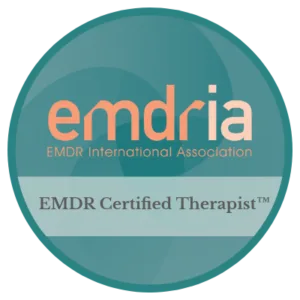If you’re a man grappling with trauma, struggling with persistent anxiety or depression, or feeling stuck in your personal journey, EMDR therapy might offer the support and clarity you’ve been searching for.
Originally developed in the early 1980’s for PTSD by Dr. Francine Shapiro, EMDR is now a versatile psychotherapy for treating a wide range of issues, including trauma, phobias, low self-esteem, and even chronic pain and erectile dysfunction.
What sets EMDR apart is its structured approach. The therapy is divided into 8 distinct phases, providing a clear roadmap that guides men through their therapeutic journey. This roadmap ensures that men have a well-defined path, making the process more accessible and manageable.
In this blog, we’ll walk you through all the 8 stages of EMDR therapy, giving a clear idea of what men (and their loved ones) can expect during each stage.
The 8 Stages Of EMDR Therapy
Eye Movement Desensitization and Reprocessing (EMDR) is an integrative psychotherapy approach that helps the brain reprocess traumatic memories. It allows you to take control of your emotions once again, address the root causes of your challenges and express feelings in a healthy way.
At Denver Men’s Therapy, each stage of the therapy is guided by a licensed EMDR-trained therapist. These therapists provide a safe and inclusive space to acknowledge and work through your emotions.
Throughout the process, you engage in specific interventions that build on one another with the goal of symptom reduction. The 8-phase process works together to desensitize distressing memories and promote adaptive resolution gradually. Here are the eight phases:
Stage 1: History and Treatment Planning
History and Treatment Planning are the foundational stages for discussing and understanding your reasons for seeking therapy. All behaviors and symptoms stemming from these reasons are also explored.
Once the therapist understands your history they develop a personalized action plan, with careful attention to the pacing of therapy and the selection of traumatic events to address.
Stage 2: Preparation
In the preparation stage, your therapist thoroughly explains the EMDR process and addresses your concerns. During this phase and all other phases, it is essential to build a secure therapeutic alliance built on mutual trust, respect, and understanding.
At Denver Men’s Therapy, we identify and strengthen the many positive aspects of your masculine strength, such as being a father or a provider, a protector, a good friend, or a hard worker.
You are taught powerful, evidence-based techniques to manage intense emotions that may arise during sessions. These skills can also be used between sessions as needed. You will learn containing, grounding, and calming skills that all men can benefit from. These skills help you stay grounded and regulate responses effectively.
Stage 3: Assessment
This stage starts by identifying a specific negative memory or event to focus on. The therapist and client work to identify the negative beliefs, emotions, or body sensations linked to this target memory. They measure your emotional responses’ intensity using Subjective Units of Disturbance (SUD) and Validity of Cognition (VOC).
The assessment stage aims to identify and increase the intensity of the negative memory that will be desensitized and reprocessed. In the safety of the therapy office, the client is encouraged to bring up as much of the memory as they can tolerate. The client has the power to stop at any time if they are feeling too overwhelmed.
The next three phases are collectively referred to as the ‘reprocessing’ phases. Each stage builds upon the previous one, guiding you to take control of your emotional well-being.
Stage 4: Desensitization
During desensitization, therapists use bilateral stimulation like eye movements, sounds, and other tasks to reprocess traumatic memory.
The memory is reprocessed until the associated distress levels diminish. As therapy progresses, you may experience new thoughts, sensations, or emerging feelings.
This phase is challenging yet transformative. It allows you to process and integrate the memory in a more adaptive way.
Stage 5: Installation
After desensitization of the memory is done, the installation stage begins. It focuses on associating and strengthening a positive belief with the targeted memory.
For men, these positive beliefs include:
- “I am a strong man.”
- “I am enough and worthy.”
- “I can protect myself and others.”
- “I am a loving and good man.”
- “I can safely express my emotions.”
- “I can succeed.”
- “I am capable.”
Through repeated sessions, you will be guided until these positive beliefs feel true and are deeply integrated with your memory.
Stage 6: Body Scan
Once the positive response is instilled, your therapist examines if there is any remaining physical tension or sensation linked to the memory.
For example, you might experience an increased pulse or muscle tension while thinking about the targeted event. If any such lingering disturbances are found in your body’s response, it is targeted for reprocessing.
The final two phases ensure continuity and progress, both at the end of each session and at the start of the next.
Stage 7: Closure
Every session of reprocessing ends with closure.
It ensures that you leave each therapy session feeling stable and return to a state of calm in the present moment whether the reprocessing is complete or not.
The structured closure through this stage helps integrate the work done in each session and equips you with practical tools for ongoing emotional shifts.
Stage 8: Reevaluation
Reevaluation stage occurs at the beginning of each session, to review changes in your emotional distress levels.
Your therapist assesses the effectiveness of the therapy by checking if the positive results from the previous sessions are maintained. They also identify any new areas that require attention.
By targeting and reprocessing disturbing emotions and physical sensations associated with past experiences, EMDR enables you to develop healthier coping mechanisms and reduce negative self-beliefs.
How Long Does Each Phase of EMDR take?
The duration of each stage in EMDR therapy can vary depending on individual progress and the complexity of the issues being addressed.
EMDR typically involves a structured treatment plan spanning 6 to 12 sessions, with each session lasting approximately 60-90 minutes. This time frame allows for a thorough and personalized healing process tailored to the specific therapeutic needs of each individual.
Throughout the course of EMDR therapy, the stages unfold progressively to facilitate deep emotional processing. By providing a structured yet personalized approach to healing, Denver’s Men’s therapy ensures that you receive the necessary guidance to effectively process past traumas and take control of your lives.
Key Benefits of EMDR Therapy for Men
From early childhood, men are often conditioned to view emotional expression as a sign of weakness. This conditioning persists into adulthood, creating challenges in breaking free from ingrained beliefs.
EMDR therapy empowers men by addressing both societal pressures and internal emotional barriers specific to the gender role.
Here are the key benefits for men:
1. Avoiding Detailed Discussions
I Don’t Want To Talk About It
For some men, the idea of discussing painful memories or experiences in detail may seem productive or helpful. However, they might also find talking about trauma too overwhelming or embarrassing.
EMDR therapy offers an alternative approach. It doesn’t require lengthy, in-depth discussions about the negative experience. Instead, men are encouraged to talk less and focus more on their present feelings and sensations.
2. Managing overwhelming emotions:
Men often fear that therapy will overwhelm them or trigger an uncontrollable surge of emotions. With EMDR, men learn calming and containment strategies early on, empowering them to manage distressing memories and emotions effectively. This equips them to explore their emotions safely without feeling overwhelmed.
3. Identifying root cause of the issues:
Many men come to therapy unsure of the underlying causes of their symptoms. EMDR therapy helps uncover and process past negative experiences that contribute to current challenges such as anxiety, anger, or relationship difficulties.
4. Strengthening healthy masculinity:
EMDR therapy for men acknowledges and works to build on the unique strengths, resources, and skills that men possess. By doing so t men can develop a more balanced and authentic sense of self, leading to greater self-acceptance and personal fulfillment.
5. Focusing on action-oriented approach
EMDR therapy is action-oriented, addressing past, present, and future memories that contribute to current symptoms. This proactive method ensures that therapy is not just about talking but actively working towards overcoming challenges and improving overall well-being.
In essence, EMDR therapy for men at Denver Men’s Therapy combines advanced clinical expertise with a deep understanding of men’s issues. It offers a transformative journey that honors men’s strengths while effectively resolving barriers to emotional well-being.
Final Reflections on EMDR Journey for Men
Emotional expression is not a sign of weakness but that of courage and resilience. By taking charge of emotional well-being with therapies like EMDR, men can lead more fulfilling lives and foster deeper connections with those around them.
Throughout the eight stages of EMDR, you’ll be guided by a trained licensed therapist in a safe and inclusive environment. Each stage plays a vital role in promoting lasting change, ultimately empowering you to confront past experiences.
If you or a loved one is struggling with mental health issues or feels stuck in personal growth, consider EMDR therapy.
At Denver Men’s Therapy, our experienced and licensed therapists can work with you to see if EMDR is right for your needs.
Don’t wait to take the first step towards the future you deserve. Contact Denver Men’s Therapy and schedule a consultation today.
Take care and be kind to yourselves.
Frequently Asked Questions
1. Do patients cry during EMDR?
Individuals may experience a range of emotions, including crying, during EMDR as they courageously confront and process traumatic memories. This emotional release is a natural part of the healing process.
2. What are the primary goals of EMDR?
EMDR helps individuals in symptom reduction or resolution by processing and reframing traumatic memories.
3. What happens to your brain during EMDR?
EMDR therapy engages the brain’s natural healing mechanisms. It focuses on distressing memories while stimulating bilateral brain activity through eye movements, taps, or sounds. This process encourages the brain to reprocess these memories.
It connects fragmented elements of the memory with more adaptive information, reducing the emotional charge associated with the trauma. Over sessions, this reprocessing shifts how the brain perceives and stores the memory, promoting emotional healing and adaptation.
4. Who is EMDR not good for?
EMDR may not be good for people with severe dissociative disorders or psychosis. The therapy’s emotions could be overwhelming for them. In such cases, a more gradual approach may be recommended.
5. How do I know if EMDR therapy is right for me?
The best way to determine if EMDR is the right approach for your needs is to consult with a licensed EMDR therapist. They can assess your specific goals and challenges and provide guidance on whether EMDR is the most appropriate treatment.
6. Is each phase of EMDR therapy conducted in one session?
No. The 8 phases of EMDR are typically spread across multiple sessions, with some phases occurring within a single session. This allows for a gradual and well-paced healing journey.
7. Can EMDR therapy be customized to suit individual needs within its 8 phases?
Absolutely. EMDR therapy is flexible. It can be adapted to the individual’s needs and goals. This happens within the 8-phase framework.














